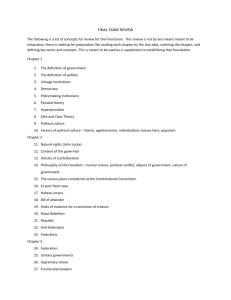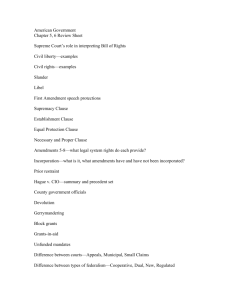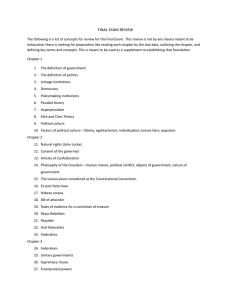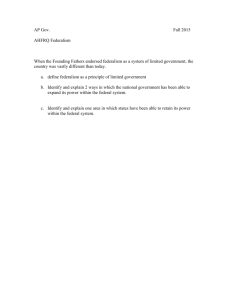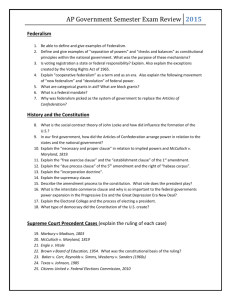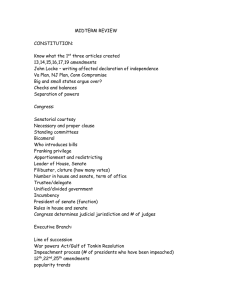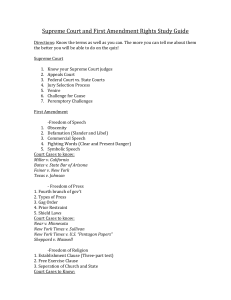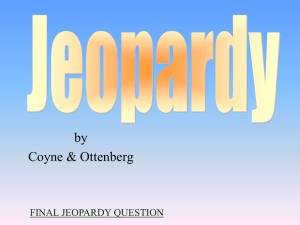Cruzan, By Marshall L. Wilde, JD, LLM
advertisement
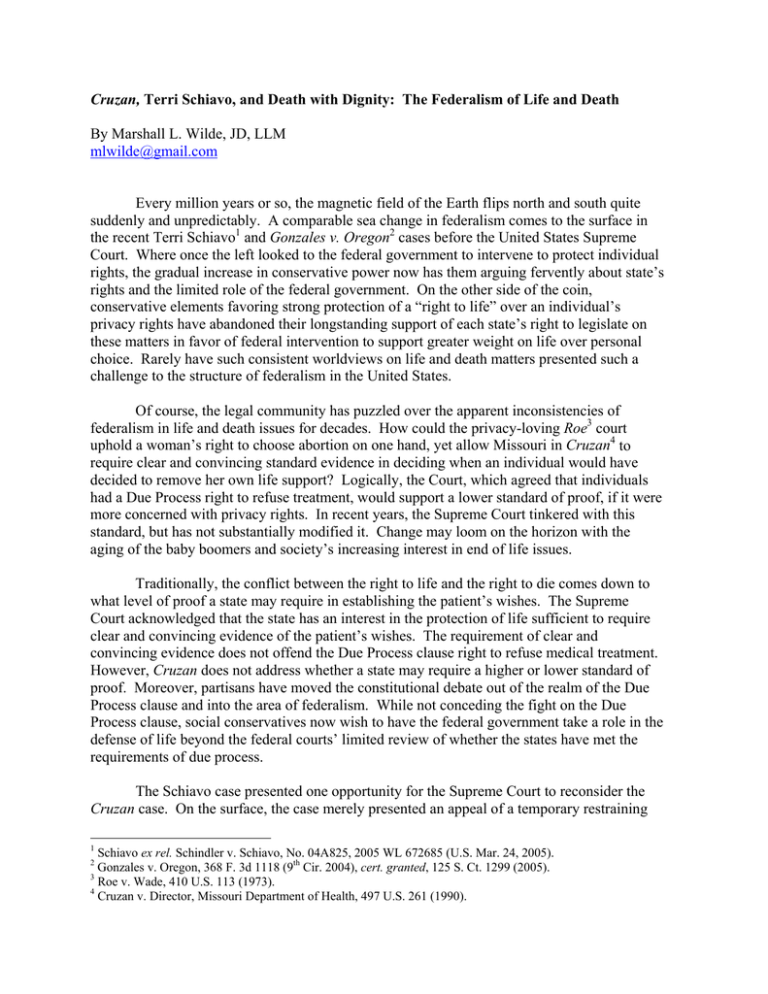
Cruzan, Terri Schiavo, and Death with Dignity: The Federalism of Life and Death By Marshall L. Wilde, JD, LLM mlwilde@gmail.com Every million years or so, the magnetic field of the Earth flips north and south quite suddenly and unpredictably. A comparable sea change in federalism comes to the surface in the recent Terri Schiavo1 and Gonzales v. Oregon2 cases before the United States Supreme Court. Where once the left looked to the federal government to intervene to protect individual rights, the gradual increase in conservative power now has them arguing fervently about state’s rights and the limited role of the federal government. On the other side of the coin, conservative elements favoring strong protection of a “right to life” over an individual’s privacy rights have abandoned their longstanding support of each state’s right to legislate on these matters in favor of federal intervention to support greater weight on life over personal choice. Rarely have such consistent worldviews on life and death matters presented such a challenge to the structure of federalism in the United States. Of course, the legal community has puzzled over the apparent inconsistencies of federalism in life and death issues for decades. How could the privacy-loving Roe3 court uphold a woman’s right to choose abortion on one hand, yet allow Missouri in Cruzan4 to require clear and convincing standard evidence in deciding when an individual would have decided to remove her own life support? Logically, the Court, which agreed that individuals had a Due Process right to refuse treatment, would support a lower standard of proof, if it were more concerned with privacy rights. In recent years, the Supreme Court tinkered with this standard, but has not substantially modified it. Change may loom on the horizon with the aging of the baby boomers and society’s increasing interest in end of life issues. Traditionally, the conflict between the right to life and the right to die comes down to what level of proof a state may require in establishing the patient’s wishes. The Supreme Court acknowledged that the state has an interest in the protection of life sufficient to require clear and convincing evidence of the patient’s wishes. The requirement of clear and convincing evidence does not offend the Due Process clause right to refuse medical treatment. However, Cruzan does not address whether a state may require a higher or lower standard of proof. Moreover, partisans have moved the constitutional debate out of the realm of the Due Process clause and into the area of federalism. While not conceding the fight on the Due Process clause, social conservatives now wish to have the federal government take a role in the defense of life beyond the federal courts’ limited review of whether the states have met the requirements of due process. The Schiavo case presented one opportunity for the Supreme Court to reconsider the Cruzan case. On the surface, the case merely presented an appeal of a temporary restraining 1 Schiavo ex rel. Schindler v. Schiavo, No. 04A825, 2005 WL 672685 (U.S. Mar. 24, 2005). Gonzales v. Oregon, 368 F. 3d 1118 (9th Cir. 2004), cert. granted, 125 S. Ct. 1299 (2005). 3 Roe v. Wade, 410 U.S. 113 (1973). 4 Cruzan v. Director, Missouri Department of Health, 497 U.S. 261 (1990). 2 order (TRO). In any TRO hearing, the plaintiff must demonstrate that they would probably prevail at the full hearing of the case. The appellants made a number of arguments, but challenged the lower court’s finding that they would not prevail. On a deeper level, it gave the court a chance to re-examine whether Florida’s clear and convincing evidence standard adequately protected the state’s interest in Terri Schiavo’s life. The Court decided in Cruzan that the state had sufficient interests in the right to life to require that standard, but what happens when the lower courts apply that standard in a manner unpalatable to the more conservative elements now in power? Conceivably, the Court could have required the higher “beyond a reasonable doubt” standard, although the Court has rarely imposed that standard in civil disputes, outside of quasi-criminal juvenile delinquency and Indian Child Welfare Act (ICWA) cases. The Supreme Court recently took under consideration Oregon’s Death with Dignity Act. Gonzales v. Oregon gives the Court has ample opportunity to avoid consideration of difficult life and death issues, as the case presents as an issue of the Attorney General’s authority to issue a policy regulation defining the legitimate scope of medical care without following the provisions of the Administrative Procedures Act. However, on a deeper level, the Oregon case presents the logical extension of the Court’s deference to the states in the Cruzan and Washington v. Glucksberg5 cases, where the Court found that the state had an interest in protecting life sufficient to prohibit assisting suicide or removing life support without clear and convincing evidence of a person’s intent. However, delving further, the Death with Dignity Act represents a challenge to the state’s interest in life, rather than privacy, because it not only permits the hastening of death, but does so in an extrajudicial process. Of course, people have managed to die extrajudicially as they choose since long before there were courts or states to take umbrage. However, the explicit authorization of a “right to die” represents a true novelty in American law and will undoubtedly continue to generate high visibility litigation, despite the probability that the Supreme Court will dispose of the case before it on narrower grounds, consistent with its institutional policies. In doing so, however, it will leave the field of federalism in life and death issues distinctly without signposts. The time constraints involved in the Schiavo litigation undoubtedly played into the federal Courts’ decisions to leave the federalism argument untouched. The Supreme Court’s earlier decisions primarily dealt with an individual state’s ability to regulate life and death through their constitutionally reserved and extensive power to regulate the lives of their citizens and not the federal government’s limited ability to regulate these issues. Cases involving the federal government’s constitutional power to regulate the right to die are rare. Congress justified the federal authority imposed in the Controlled Substances Act through the Commerce clause, but the Commerce clause seems to have little to do with the real issues involved in the Death with Dignity Act. Commerce has even less to do with the removal of food and water involved in the Schiavo case, as that removal did not involve controlled 5 Washington v. Glucksberg, 521 U.S. 702 (1997). 2 substances. The Court has effectively passed on the opportunity to address the issue through the Due Process clause by the Cruzan decision. The creative plaintiff’s attorneys in the Schiavo case, perhaps taking heart in the evolving standards discussed in the Supreme Court’s recent prohibition of the juvenile death penalty, sought to implicate the Cruel and Unusual Punishment clause. However, the withdrawal of food and water in that case manifestly did not involve state action, but rather a limitation on state action. Conservative elements find themselves in the position long held by liberals, casting about for a constitutional hook on which to hang their coat. We should not fault the Founding Fathers too seriously for their lack of foresight. How could they have known to address these issues in the drafting of the Constitution, when medical science had not yet invented the tools to make a long twilight between life and death possible? They had prescience enough to limit the power of the central government to an enumerated list of powers, a wisdom recently reinvigorated by the Supreme Court in the Lopez6 case. Lopez found Congress’s powers under Commerce clause insufficient to justify a ban on guns in school zones. Lopez came at the end of a forty-year run of liberal ascendance in the Congress. We find ourselves just over a decade into a new conservative majority. It seems doubtful that even the most result-driven court will effectively overturn Lopez by announcing the discovery of a new continent of federal power in the legal terra incognita. Since the conservative majority has not yet reached the apex of power defined by the ability to amend the Constitution, it appears legal scholars and bioethicists will continue to suffer the lack of consistency inherent in the reservation of these issues to the states, in all their idiosyncratic majesty. The poles have reversed in terms of the position of medical professionals and patients on life and death issues as well. Historically, hospitals and medical professionals advocated strongly to maintain life, even in the face of the patient’s clearly expressed wishes. Recently, The New York Times reported that the culture of the medical profession has changed so much that physicians often now push families to terminate life support when the potential for any meaningful consciousness has passed.7 Further, a few states have moved towards permitting hospitals to remove life support, even contrary to the family’s wishes, when the patient reaches the point of medical futility. These laws present yet another challenge to considering federal involvement. Do these laws adequately protect the patient’s right to life under the Due Process clause? If so, may Congress nevertheless override them with federal legislation? What would the constitutional basis for the legislation be? Given that medical care for a person in a persistent vegetative state costs at least $40,000 a year, who will pay for this care? As so clearly evidenced by abortion rights cases, a privacy right does not automatically implicate a right to exercise that right free of charge. Currently, when a patient exhausts their insurance and private resources, Medicaid takes over the cost of care. However, Medicaid faces significant funding challenges in the near 6 U.S. v. Lopez, 514 U.S. 549 (1995). Pam Belluck, Even as Doctors Say Enough, Families Fight to Prolong Life, N.Y. TIMES, Mar. 27, 2005, available at http://www.nytimes.com/2005/03/27/national/27death.html (last visited Mar. 28, 2005). 7 3 future. Further, society will legitimately debate the social utility of maintaining a patient in a persistent vegetative state versus that of providing prenatal care for dozens of indigent women for the same money.In sum, recent events present significant challenges to the traditional roles of the state and federal governments in right to die cases. Litigants will ask the courts to move beyond the traditional due process analysis and recognize an independent federal right to life. Congress may try to legislate a federal right to life based on the now limited Commerce clause or seek a new and novel basis for federal intervention in this area. While parties have reversed polarity on federalism, the courts find themselves with a conservative body of law supporting a very limited role for the federal government in right to die cases. The pressure to allow the federal government to take a bigger role in right to die cases represents a major challenge to federalism and the intellectual honesty of the judiciary. 4
